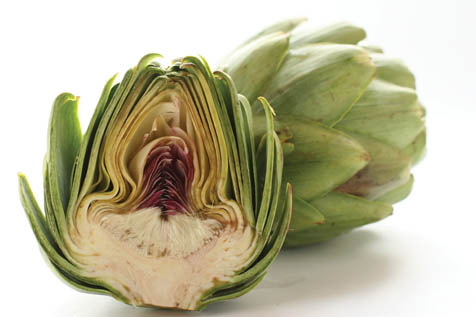Growing Artichokes in S.B.’s Climate
The Tasty Thistle

If ever there was a vegetable that children would naturally abhor, the artichoke would be such. In my childhood, however, there must have been some magical moment when my budding palate met the semi-starchy texture, the mellow greenness of the artichoke. For both the thin layer of concentrated flavor scraped off the lower part of the “leaves” (really flower bracts) and the perfection of the few bites of the “heart” (the hypanthium) were instantly one of my favorites. My first experiences were probably augmented by the fact that the artichokes I was eating had been recently harvested, in season, just miles from my grandparents’ home in Santa Cruz. Castroville is rightfully acknowledged as the artichoke capital of the world, and it was just down the highway a few miles.
The artichoke (Cynara scolymus) is a perennial, native to the Mediterranean region and much beloved there. Our Californian varieties are pumped-up versions of the many selections that Italians, French, and all the other inhabitants of countries that face the Mediterranean Sea eat. There, the succulent young buds are often eaten whole and have little of the “choke” to bother. Artichoke is a relative of thistles and within its developing flower are the beginnings of a plethora of stiff, needle-like structures that will, if allowed, turn into wind-blown fluff to carry the seeds off to a new life. Even in the juvenile stage they need to be removed before the diner can get at the succulent heart.
Artichokes available in nurseries here are of the globe type-just like those we buy in the market. Standard varieties will appear bareroot in the early winter for immediate planting or as young plants a few months from now. They require full sun, but can tolerate a bit (only a bit) of shade and require regular water to get them established and then to assure a good crop. Artichokes can also be quite drought tolerant, and used as an ornamental they are very handsome with their fountain of deeply divided, coarse, gray leaves. If you leave the flower buds to mature instead of eating them, they open to reveal a large, striking thistle head of purplish-blue.
January Tips
• Prune deciduous trees and shrubs (fruit trees, roses, flowering cherries,and plums, etc.) when their leaves have all fallen.
• Buy deciduous trees and shrubs (see above) bareroot this month. If you can’t plant immediately, protect roots from drying out with damp sand, peat moss, or compost.
• Spray deciduous trees and shrubs that are susceptible to insect and fungal attacks. Horticultural oils and compost tea are the safest to use, but limited use of fixed copper or lime sulfur sprays can get the upper hand on things like stubborn peach leaf curl.



